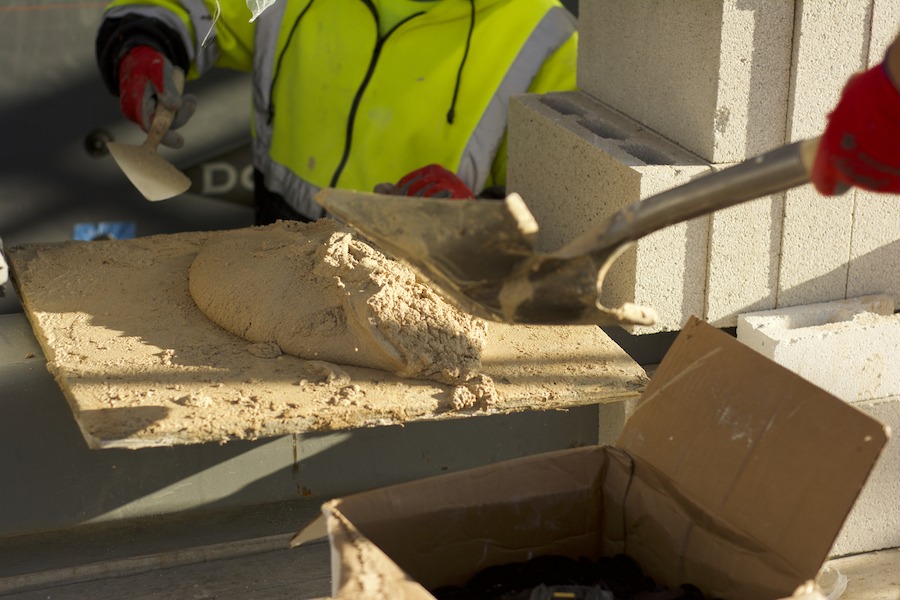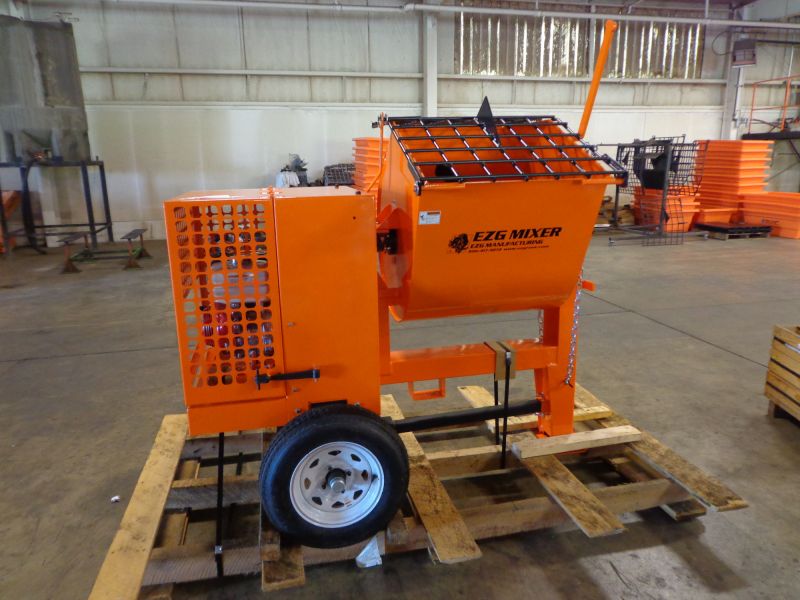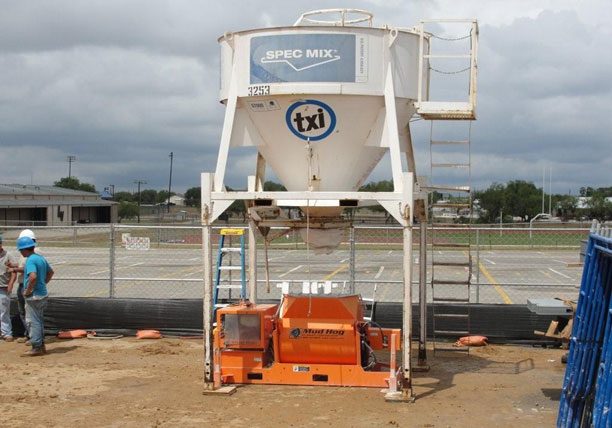The masonry industry has gone through many changes throughout the years. Mega structures continue to get larger, cities are growing and require infrastructure to meet these advancements. Similar to this growth, advances in equipment are taking place to keep the speed of construction up with the growth of the cities. Advanced mortar and concrete mixers and systems are helping contractors keep up with the pace.
Years ago most contractors mixed both mortar and concrete in cone style drum type mixers that tumbled the material in order to mix it. With the tight deadlines that most projects require these days, drum type mixers will not keep up with the pace of construction.
There are varieties of innovations and differences when it comes to mixers. From pull behind to skid mounted, electric start vs. pull cord, hydraulic verses belt driven, low load/high dump vs. high load/low dump.
As the industry continues to change in, so does it change how masons do their work. Effective June 23, 2017, new silica laws go in place that will be enforced by the Occupational Safety and Health Administration (OSHA) to control silica dust that is created on jobsites. Although silica exposure (which is harmful to a person’s health) is hardly present when mixing mortar or concrete, compared to when cutting, grinding or hammering concrete, the dust that is created during mixing process is sure to raise eyebrows on jobsites and lead to OSHA visiting those jobsites where mixer dust is not controlled.
For the construction industry, the new silica law will require mixer innovations in the masonry industry to consider these new provisions. Here are the modern methods used in the masonry industry to when preparing mortar or grout.
Systems of loading mixers:
Many contractors still mix mortar, grout and concrete by the shovel loading method. Especially on residential projects. The issue inspectors on commercial sites have with this is the difficulty of getting the same shovel full of sand each time, and/or the laborer miscounting during the loading process leaving the possibility of inconsistent mixes.
Ever since the early 1980s to date, contractors have been more informed on the production of consistent mortar that would meet the architectural specifications once common field test is done.
This has resulted in an increase of systems for loading mixers by measuring the materials that go into the mixer. Some jobsites use silos or premixed bags of cement or mortar, while others use cubic foot boxes or skid loaders with mounted buckets to install the correct amount of materials per bag of mortar or concrete that needs to be mixed.
Ready mixed mortar or grout delivered using a truck
With ready mix trucks, the Mortar or concrete is normally mixed at a plant before being transferred to the job site. Alternatively, this process can be done at the job site before being placed in wheelbarrows or tubs. A mobile mixer or batcher is used.
It was a real breakthrough when the concept of a ready mixed mortar was initially released. However, it had been used in Europe since the 1970s. Quality control was greatly improved as it eliminated utilizing shovel counting as a method of measuring while mixing. In addition, there was increased productivity that allows construction workers to manage other jobs and bricklayers begin their job immediately.
The downside of using mortar or concrete out a ready mix truck is the life cycle of freshly mixed concrete or mortar. Ready mix trucks mix large quantities at once that must be used within a short period of time, or the product mix is not permitted to be used in the wall or on pads.
Silos are used on many larger jobs these days. Up to six 3,000 pound premixed bags of mortar or grout are delivered to the jobsite, then loaded into the silos with forklifts. Once these silos are loaded with the forklift, the laborer mixing the mortar or grout pulls a lever at the bottom of the silo to dispense the material into the mixer below.
These silos have improved the productivity of the jobsite. Although the material comes at a higher price, they help offset labor costs as there is no hand mixing required. The contractors that use silo mixers say they can manage to produce large quantity mortar when needed on the job site.
Loading with boxes or Skid Steer Loaders
Some contractors use cubic feet boxes that are mounted to the back of their mixers to measure materials before dumping into mixers.
Manufacturers of mixers now build mixers that are driven by hydraulics and powerful enough to be loaded with skid steer loaders installing the correct amount (usually around 69 shovels) of sand at once for a three bag mortar mix. The correct amount of gravel can also be installed with these buckets during the process of mixing grout.
Differences in mixers:
Pull Behind Vs. Skid Mounted
Pull behind (economy) mixers are common on residential or smaller commercial jobsites. Most are belt and gear driven. The advantage of these mixers is low initial cost.
Skid mounted mixers are built with fork pockets to load onto a truck or trailer with a forklift. These are commonly used by contractors who have a forklift at the jobsite and their shop to load and unload the mixer onto a truck or trailer. Without wheels on the mixers, it is much more difficult for a thief to hook up to the mixer and take off with it. Also, the wheels on most pull behind mixers are in the way of the forklift forks when the operator is going in to pick up a mud pan. Therefore, unless the extra time is taken to remove the wheels once the mixer arrives at the jobsite, it is hard for the forklift operator to avoid running the forks into them and destroying them in the process.
Drum Type Mixers
Drum type mixers (often referred to as concrete mixers) although most commonly used to mix concrete or grout, can still be used to mix mortar. The disadvantage is that they tumble the material instead of cutting through it requiring more time to toughly mix the materials required in the mix. They are also more difficult to load as the charging point (opening) is smaller than those on regular mortar mixers.
These mixers are still the primary mixer in a lot of countries outside the United States.
Hydraulic Mixers
Hydraulic mixers are more common on large residential or commercial/industrial projects. Most hydraulic mixers are built with the ability to reverse the mixing paddles, should a plug occur due to the laborer not installing enough water during the mixing process.
Some manufactures go as far as using cross port relief valves built into their mixers that allows hydraulic fluid to bypass through the valve relieving excessive pressure on motors and mixer parts during a plug. This keeps the mixer from tearing itself up during the inevitable plugging process.
Unlike belt driven mixers, most hydraulic mixers can be used to mix grout as well as mortar due to their additional power and ability to reverse during a plug.
Electric Start vs. Pull Start
Economy mixers are mostly all pull start coils. The pulling process works well when the mixer is new. However, over time these pull coils are subject to break and temporally shut the mixing process down. For contractors using pull start mixers, it is wise to have extra rebuilt or new coils on site ready to quickly replace the coil should one fail causing delays in the mixing process.
Electric start on mixers gives the laborer the ability to simple turn a key to start similar to starting a vehicle. They still come with a pull cord, but it is only used to start the mixer if the laborer forgets to turn the key on the mixer off and the battery dies.
High Load/Low Dump vs. Low Load/High Dump
Traditional mixers must be loaded high enough above the ground that they can dump into a wheelbarrow or high mud pan. While these mixers come with a lower initial cost, it requires laborers to lift the material high to load the mixers.
Some mixer manufacturers are now building mixers that can be loaded at a low level while still dumping into a wheelbarrow or high mud pan. These mixers have hydraulic cylinders that raise the drum once the mixer is loaded taking the strain off the laborers back during the loading process.
Before a contractor chooses a mixer or system, he or she should consider the following:
- Size of the job
- Space provided to mix on the jobsite
- Amount of material that will need mixed
- Type of material that needs to be mixed
- Is there a forklift available to load and unload the mixer
- Dust that will be created during the mixing process
On smaller projects with loose deadlines or contractors who only mix small amounts of mortar during a years’ time, traditional mixers can generally suffice as they come with a low initial investment.
For larger projects, or contractors who do a large volume of work, the contractor should consider that less than 30% of the costs of a mixing system is incurred the day it is purchased, while over 70% is incurred during the use of the mixer or system due to efficiency and durability during the life of the mixer.
As regulations and jobsite conditions change, so does the need for advanced mixing systems.
Special Thanks: Damian Lang and Steve Wheeler of EZG Manufacturing



